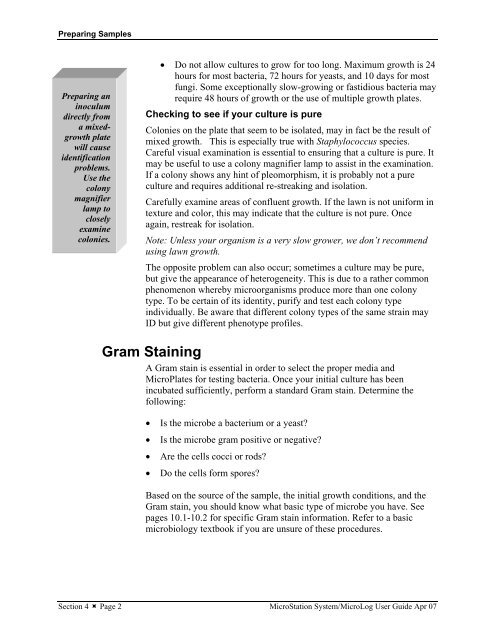MicroStation System, MicroLog Version 4.2 - DTU Systems Biology ...
MicroStation System, MicroLog Version 4.2 - DTU Systems Biology ...
MicroStation System, MicroLog Version 4.2 - DTU Systems Biology ...
You also want an ePaper? Increase the reach of your titles
YUMPU automatically turns print PDFs into web optimized ePapers that Google loves.
Preparing Samples<br />
Preparing an<br />
inoculum<br />
directly from<br />
a mixedgrowth<br />
plate<br />
will cause<br />
identification<br />
problems.<br />
Use the<br />
colony<br />
magnifier<br />
lamp to<br />
closely<br />
examine<br />
colonies.<br />
• Do not allow cultures to grow for too long. Maximum growth is 24<br />
hours for most bacteria, 72 hours for yeasts, and 10 days for most<br />
fungi. Some exceptionally slow-growing or fastidious bacteria may<br />
require 48 hours of growth or the use of multiple growth plates.<br />
Checking to see if your culture is pure<br />
Colonies on the plate that seem to be isolated, may in fact be the result of<br />
mixed growth. This is especially true with Staphylococcus species.<br />
Careful visual examination is essential to ensuring that a culture is pure. It<br />
may be useful to use a colony magnifier lamp to assist in the examination.<br />
If a colony shows any hint of pleomorphism, it is probably not a pure<br />
culture and requires additional re-streaking and isolation.<br />
Carefully examine areas of confluent growth. If the lawn is not uniform in<br />
texture and color, this may indicate that the culture is not pure. Once<br />
again, restreak for isolation.<br />
Note: Unless your organism is a very slow grower, we don’t recommend<br />
using lawn growth.<br />
The opposite problem can also occur; sometimes a culture may be pure,<br />
but give the appearance of heterogeneity. This is due to a rather common<br />
phenomenon whereby microorganisms produce more than one colony<br />
type. To be certain of its identity, purify and test each colony type<br />
individually. Be aware that different colony types of the same strain may<br />
ID but give different phenotype profiles.<br />
Gram Staining<br />
A Gram stain is essential in order to select the proper media and<br />
MicroPlates for testing bacteria. Once your initial culture has been<br />
incubated sufficiently, perform a standard Gram stain. Determine the<br />
following:<br />
• Is the microbe a bacterium or a yeast?<br />
• Is the microbe gram positive or negative?<br />
• Are the cells cocci or rods?<br />
• Do the cells form spores?<br />
Based on the source of the sample, the initial growth conditions, and the<br />
Gram stain, you should know what basic type of microbe you have. See<br />
pages 10.1-10.2 for specific Gram stain information. Refer to a basic<br />
microbiology textbook if you are unsure of these procedures.<br />
Section 4 � Page 2 <strong>MicroStation</strong> <strong>System</strong>/<strong>MicroLog</strong> User Guide Apr 07


